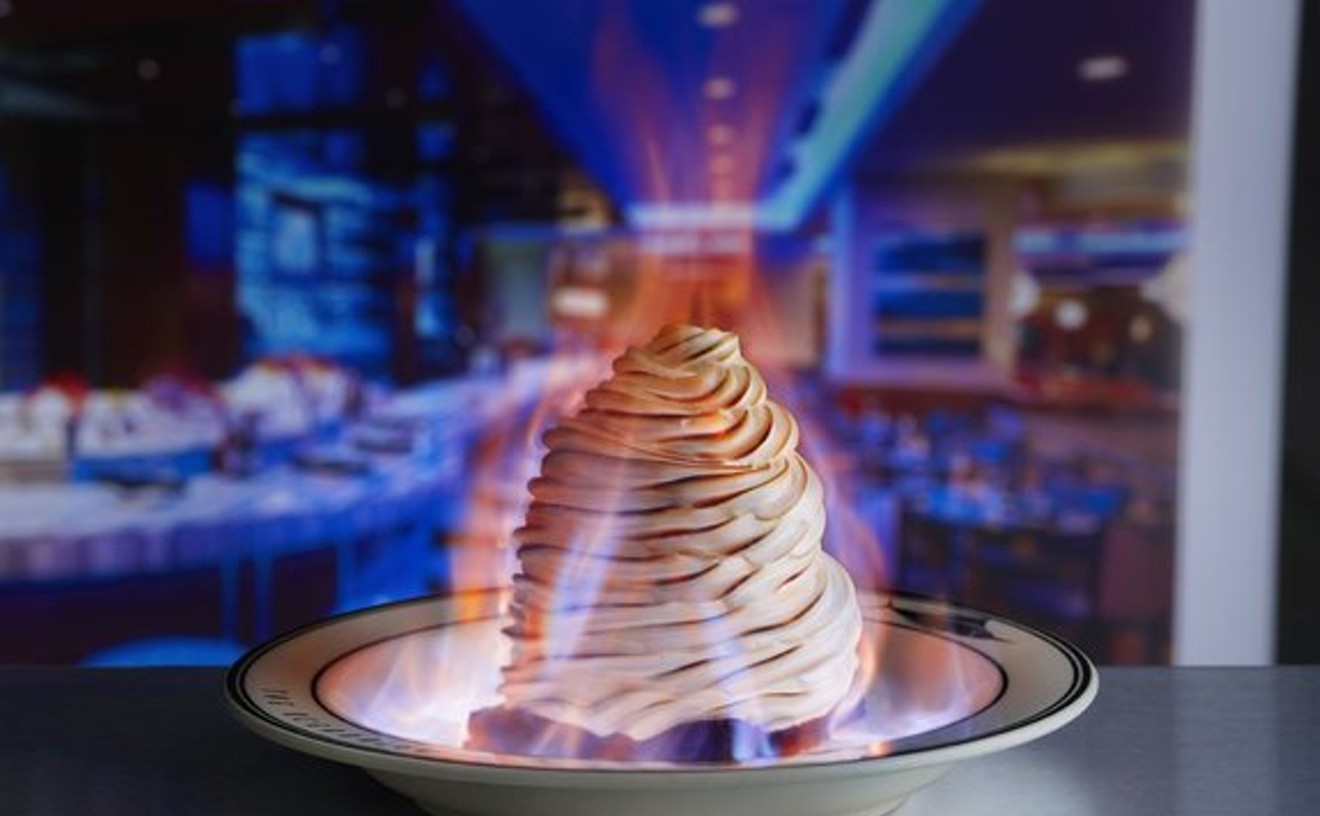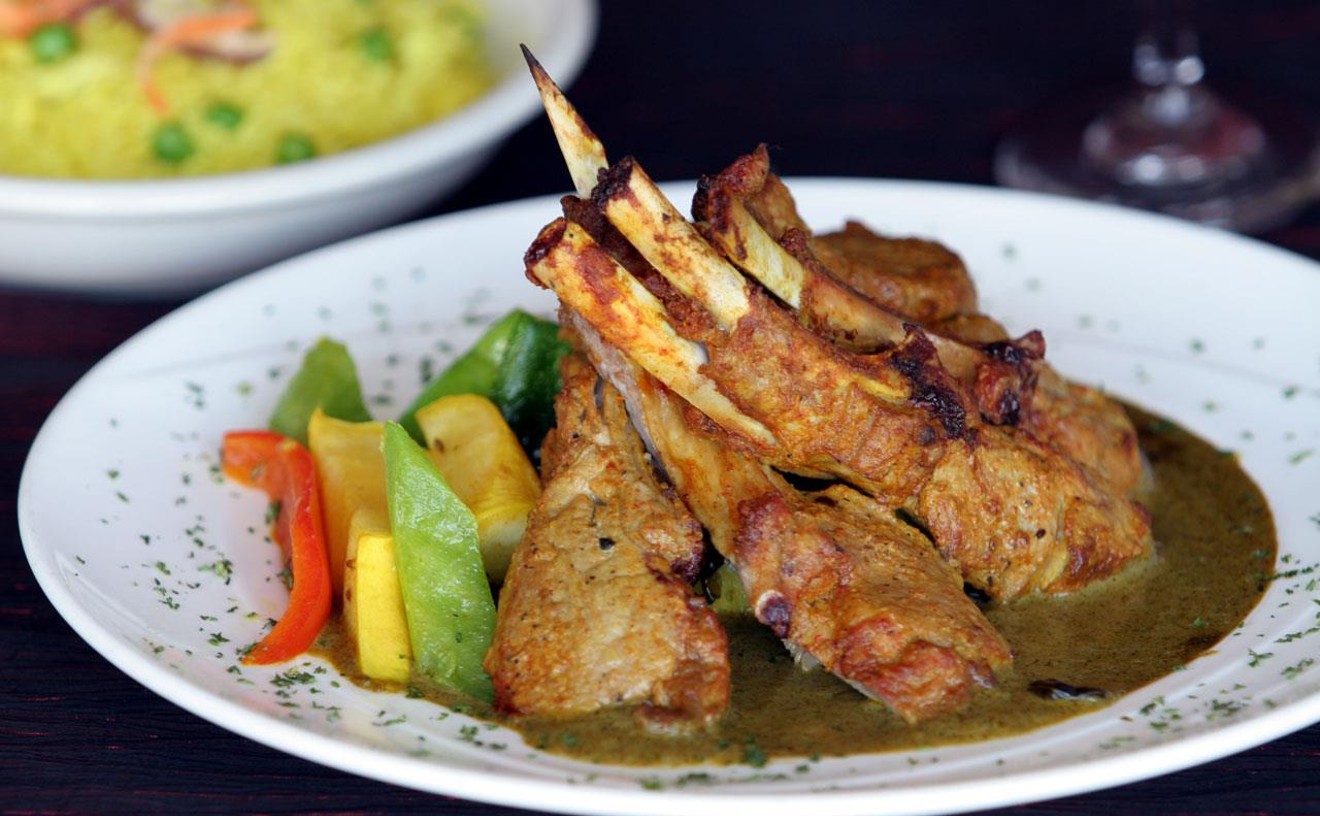Best Carpaccio
Bice Ristorante

Tom++Jenkins
Say+it%2C+bitch%3A+Bice+loves+itself+more+than+we+loved+Bice%27s+food.
A lot can be said (hype) about Bice (beach-aye, beach-aye you ice heads) Ristorante, the circa 1926 Milanese trattoria opened by Beatrice Ruggeri that later found its way to New York, Chicago, Houston, Orlando, Latin America, Saudi Arabia, Beirut, Singapore and numerous other locales. Much more should probably be left unsaid. But what should not be left unsung in this Dallas version of this Milanese marvel is the beef carpaccio. It's like the tatters of a fine camisole, nearly sheer sheets of rose networked with a wavering weave of fat channels. Covered in dribbles of black truffle Dijon mustard sauce, these sheets fray and unravel as the fork upends them and attempts to peel them from the plate. In the mouth, they're reduced to mist, filming the tongue with richness: A French kiss in Italian lip gloss wreathed in Dallas ersatz refinement.
- 100 Crescent Court, Dallas, 75201 Map
- 214-922-9055
- www.bicedallas.com
Best Seafood Restaurant
The Oceanaire Seafood Room

"To eat an oyster is to kiss the sea on the lips," reads a quote posted on Oceanaire's Web site. It's fitting this quote should be used to shill Oceanaire, a seafood-intensive dining room (oh sure, there are pork chops and rib eyes for chumps) saddled with a menu in continual flux on account of the fresh fish shipments shuttled in daily, sometimes more often. Species loaded into the Oceanaire torpedo tubes (like opah or moonfish, savor it with a Sonoma Coast Pinot) are checked off on the "fresh today" list at the top of the menu. But it's those oysters in the raw that get you, glistening with marine wetness like beads of sweat on the upper lip.
- 13340 Dallas Parkway, Dallas, 75240 Map
- 972-759-2277
- www.theoceanaire.com
Best Mexican Restaurant
Lanny's Alta Cocina Mexicana
OK, so it's not really Mexican, technically speaking. It's "high Mexican" or chichi-Mex, or froufrou-Mex--though it's more like global haute cuisine with a Mexican accent. There are no sombreros or mariachi posters on the walls. Instead, the interior is crisply contemporary with river stone, rich wood beams and contemporary art in a room washed in hushed tones. Still, Lanny's (Lanny Lancarte of Joe T. Garcia's fame) cuisine sings, even if the Mexican notes are often just little ghostly hints. Take the arctic char crusted in pulverized pumpkin seeds. It rests in a tomato jalapeo beurre blanc. Mental circuits blow contemplating the fish taco possibilities. Trout, served with warm cucumbers and dampened with a butter almond sauce, straps you into a similar state of sublimity. Achiote-roasted lamb chops are lurid. Rubbed and marinated in achiote, garlic, oregano, citrus and fresh herbs, the glistening orbs of meat are silky and rich. A flap of bok choy patiently rests nearby, waiting for the Tsingtao to make an appearance on the beverage menu. Ya gotta lime for that?
- 3405 W. 7th St., Fort Worth, 76107 Map
- 817-850-9996
- www.lannyskitchen.com
Best Sommelier
Drew Hendricks, Pappas Bros.

Once you get beyond the wine, you'll find Drew Hendricks is little more than a grunt. Joining the Army straight out of high school, Hendricks scored a tour on a family vineyard in the Baden region of Germany (it was part of an Army cultural exchange program). Here, Hendricks participated in war games where each side attempted to vanquish the other with weaponized Sptburgunder and Rulnder. Mesmerized by the tools of modern wine-fare, Hendricks decided to devote his life to stockpiling heavy weaponry: Cabernet, Syrah and Nebbiolo, for instance. Along the way, he's developed a special ops nose, an uncanny taste sensibility and a lethal memory that can extract the most stubbornly covert wine details--all without the use of sleep deprivation, loud Bone Thugs-N-Harmony rap or Victoria's Secret lingerie stretched out over the head. Stripes: co-founded the Texas Sommelier Association, was named one of the best young sommeliers (he's 29) in the country by Wine & Spirits Magazine in 2005 and scored second in the Young Sommelier competition put on by the Court of Master Sommeliers. Hendricks hates getting questions he can't answer, so be sure and brush up on your obscure Mller-Thurgau trivia. And don't forget to pack your water pistol loaded with some good Sptburgunder.
- 10477 Lombardy Lane, Dallas, 75220 Map
- 214-366-2000
- www.pappasbros.com
Best Ham Salad
Amuse Restaurant & Lounge
Ham is a cured cut from a hog's hind leg. In Italy, where it's salt-cured and pressed it's called prosciutto, which would make a really cool name for a Ferrari. Try this: F355 Prosciutto Spider. Except it would never fly in the U.S. market because nobody wants to drive a 500-horsepower hog shank, even if the name does sound cool in Italian. Anyway, most chefs can't think of anything to do with it, so they wrap cantaloupe chunks with it and call it a dish. But at Amuse the prosciutto vibrates, just like that Ferrari (in theory). Pinches of it are arranged in a row on a long narrow plate over gauzy triangles of manchego cheese. Needles of chive and julienne endive protrude from the folds like chopsticks, and strips of roasted pepper are draped over the top, playing off the cured sweetness. Vrooom.
Best Fast-Food Chicken
Marco Pollo Rotisserie
How to torture an organic chicken: bath it in white wine, rub it raw inside and out with lemon halves, soak it in dark beer, rub it with a secret blend of Peruvian spices and leave it to stew for 24 hours. Then, give it another Peruvian rub, impale it on a rotisserie over smoldering charcoal and split hickory and apple wood logs. How to reach tortured organic chicken bliss: eat the damn chicken. The spices caramelize on the crisped skin, extracting the Peruvian spice and beer sensations to the point of blood-stirring eroticism (let's be honest, chickens don't arouse when left to their own feeble devices). The caramelized spices seal in the juices. And they're cheap: A whole chicken with three jumbo sides is just shy of 14 bucks.
Best Indian Restaurant
India Palace Restaurant & Club

We like this: Most of India Palace's dcor de pink has been flushed, giving way to lush golds, dark mustards and rich burgundies heightened by brass chandeliers. Which means it's actually beginning to resemble a palace instead of a casino by Larry Flynt. At the entrance is a plastic box with slots quarantining all of the spices: mustard seed, coriander, cumin, clove, garlic, etc. These little specimens are animated into the alluring India Palace fume. And instead of loosely ethnicized schmaltz, the music is authentic. We think. Service is attentive and prompt. The food ranks up there with the dining room fragrance. Saag paneer (cheese in creamed spinach) is rich and well-sassed with a complex Indian spice blitz. Marinated in yogurt, ginger and garlic, tandoori chicken is as moist as it is zesty (usually it's as dry as burlap and as orange as a traffic cone), even when plucked from the lunch buffet. The whole India Palace bounty horn, from the fresh Indian breads to the lamb bahuna, screams with alluring sensuality.
- 12817 Preston Rd. #105, Dallas, 75230 Map
- 972-392-0190
- www.indiapalacedallas.com
Best Cajun Restaurant
Margaux's, a Restaurant by Design

Tucked into Dallas' design district, Kay Agnew's Margaux's is a breath of fresh lunch munch fueled by hot licks of Creole and Cajun brashness artfully designed to kick you out of your luncheon ennui. Red beans and rice with andouille sausage? Oh-so-supple firm beans poured over fluffy separate rice grains with flecks of scallion. Soft shell crab is littered with pecan debris and spit-bathed in a rich lemon beurre blanc. And who can say nyet to popcorn crawdads? What's odd is all of this lusty Cajun sweat is dressed in high-class contemporary design threads, which means white (walls and ceiling beams) and black (table cloths and napkins) plus a vase of sticks welded to a mirror here and there. Very haute but very un-Cajun.
- 150 Turtle Creek Blvd., Dallas, 75207 Map
- 214-740-1985
- www.margauxsdallas.com
Best Vietnamese Restaurant
Qu�n Kien Giang Vietnamese Cuisine
While many of us don't like them, we all have a voyeuristic fascination with whole fish arriving on a plate: tail, fins, head and gills fully intact. We try to decipher its blank expressions, play stare-down with the eye sockets, try to find the thing's tongue. In most places, you order a whole fish and it slumbers on the plate, maybe in a bath of citrus, scallions, spices, peppers and some fermented fluid to race it up. But at Qun Kien Giang, the whole (fried) fish (our server didn't know how to translate the species into English) is upright, resting on its belly, flaunting its spiny fins and scales like an array of vicious military armor. The meat is pulled off the sides and bunched up near the fish's belly--like a pair of trousers rumpled around the ankles--leaving the exposed needle-like rib bones, adding to its menacing posture. Meat is moist and tasty, though, but that's Qun Kien Giang. It's a secret space loaded with compelling surprises and gripping mysteries. Hearty hot pots, viciously spicy soups littered with pert vegetables, fondues loaded with bright green foliage and hot pans for sizzling beef slices and seafood--all fresh and delicious. Plus there's a special marathon meal called "seven courses of beef" designed to load you up so that you have to be hauled out like a whole fish on a plate.
- 9560 Skillman St., Dallas, 75243 Map
- 214-221-0043
Best Thai Restaurant
Nakhon Thai
It's a distinctive notch of Thai splendor. You have statues and statuettes of gods and warriors, reliefs of beautiful Thai women and photographs of Thai royalty. Plus, there is the tinkle and splashing of fountains in the entrance. Furnishings are all Thai imports, from the glossy web-worked wood chairs to the god sporting multiple limbs engraved on an urn. But it's the food that gets you, from the supple and greaseless sweet corn patties to the delicious steamed whole fish ever threatening a potent chili sting, to the rich and creamy panang riddled with red chili and kaffir leaves. Pad Thai is exhilarating: supple and separate noodles and sprouts (no sticky pad rat's nest) and real peanut debris (no Jif or Skippy), all draped in a smooth supple omelet, so you can box up what's left and have it for breakfast. This is the coolest Thai indulgence since Thai stick.





